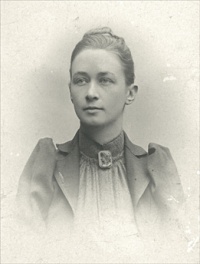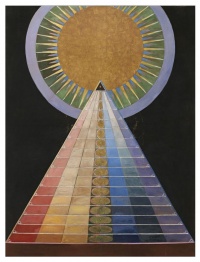Hilma af Klint

Hilma af Klint, (October 26, 1862 – October 21, 1944) was a Swedish artist and mystic whose paintings were amongst the first abstract art. A considerable body of her abstract work predates the first purely abstract compositions by Kandinsky.
Early Life and Education
Hilma af Klint was born in Sweden on October 26 1862, the fourth child of Captain Victor af Klint, a Swedish naval commander, and Mathilda af Klint (née Sonntag).
At an early age she showed signs of artistic aptitude, though her true interests included mathematics and botany. When the family moved to Stockholm, af Klint studied at the Academy of Fine Arts of Stockholm, where she learned portraiture and landscape painting. At the age of 20, she was admitted to the Royal Academy of Fine Arts and during the years of 1882–1887 she studied mainly drawing, portrait and landscape painting. She graduated with honors and was given studio space in the Atelier Building as a scholarship. Hilma af Klint began working in Stockholm, gaining recognition for her landscapes, botanical drawings, and portraits, providing a source of income.
Artistic Career
The Five
Around the age of seventeen, af Klint became involved in spiritualism. She became interested in Theosophy and the philosophy of Christian Rosenkreutz, then later anthroposophy developed by Rudolf Steiner.
While at the Academy of Fine Arts, af Klint met Anna Cassell who would be one of the four women in her group called the Five (de Fem). Between 1896 to 1906, the spiritualist group made up of female artists, would gather on Fridays and conduct seances to connect with the spiritual realm. The women would carefully record what happened during their meetings in notebooks.
As Jochen Volz, General Director of the museum Pinacotea de Sao Paul in Brazil and curator of show, “Hilma af Klint: Mundos Possíveis (Hilma af Klint: Possible Worlds)” wrote:
“They would always start with a prayer or song, then read a certain sequence from the New Testament and discuss it. Then they would get into a state of consciousness where they could communicate with higher spirits, who they called ‘The High Masters (Höga Mästare)’.”[1]
During their seances, the Masters would present themselves by name and promise to help the group in their spiritual training. Over the years, af Klint functioned as the sole medium of the group. She would create automatic drawings, a practice that would be popular amongst Surrealists in the 1920s. Af Klint’s hand would move automatically and without her will, making her an artistic tool for the group’s spirit leaders. She was constantly surprised by the result of her unconscious activities and would be unable to explain them.
After years of these seances with the Five, af Klint accepted a major assignment from one of the Masters, the Paintings for the Temple. This commission, in which she would be engaged between 1906 and 1915, would change the course of her life.
Paintings for the Temple
In 1906, af Klint received a commission from one of the High Masters. These series of abstract paintings would be known as Paintings for the Temple, though admittedly she never understood what the Temple actually referred to. It is one of the very first pieces of abstract art in the Western world, as it predates by several years the first non-figurative compositions of her contemporaries in Europe.[2]
The creation of Paintings for the Temple was carried out in two phases between 1906-1915, with an interruption between 1908 to 1912. The series contained 193 paintings, grouped in several series and subseries. She explained that the pictures were painted “through” her with “force” – a divine dictation: “I had no idea what they were supposed to depict…I worked swiftly and surely, without changing a single brush stroke.”[3]
The major paintings, dated 1907, are extremely large in size. Aptly called The Ten Largest, each painting of the series measures approximately 240 cm x 320 cm describing different phases of life, from early childhood to old age. The paintings often depict symmetrical dualities (up and down, in and out, good and evil), while her color choice should be seen as metaphorical.
Once the whole series was completed in 1915, af Klint claimed she ceased to receive guidance from the High Masters. However, she continued with abstract painting, independently from any external influence.
Theosophical Society involvement
On May 23, 1904, Miss af Klint joined the Stockholm Lodge of the Theosophical Society headquartered in Adyar, Chennai, India.[4] There is evidence that she participated in a Swedish lodge as early as 1889, but little is known about that earlier involvement.
Her art definitely had a Theosophical influence. By the late 1870s she began to participate in séances, and soon developed an interest in Theosophy and the occult, as would be the case of Mondrian and Kandinsky some years later.
Hilma af Klint was only introduced to a wider audience at the 1986 The Spiritual in Art exhibition. She was trained and initially worked as a conventional artist, but in the 1890s af Klint participated in Spiritualist sessions and started to draw under the influence of spirits. She owned a Swedish edition of Blavatsky's Secret Doctrine and Theosophical ideas quickly gained ground within these sessions. Between 1905 and 1907 af Klint realized a first series of esoteric paintings, called "drawings for the temple," created under the guidance of a spirit called Amaliel. After meeting [Rudolf] Steiner in 1908 she ceased painting to study Anthroposophy, eventually returning to and finishing the temple-series between 1912 and 1915. The series explores the major Theosophical theme of the cosmic dynamics between male and female and their eventual unity, also central to Mondrian's work. Her works are, notably, abstract. Similarly to the other artists associated with Theosophy, form (mostly abstract) was of prime importance to af Klint, as well as a particular symbolism of color; for her blue, the lily, and the eye represented femininity; yellow, the rose, and the hook masculinity (Lampe 2008: 130). She never exhibited during her life and left an oeuvre of over 1,000 paintings (Rousseau 2008).[5]
Additional resources
- Seven articles about Hilma af Klint are listed in the Union Index of Theosophical Periodicals.
- "Art and About: Hilma af Klint".
- Bax, Marty. "Hilma and the Enigmatic Mathilde N." Bax Art Concepts & Services blog. October 4, 2013. Available at Baxpress.blogspot. Viewed October 21, 2016.
- Hilma af Klint: Painting the Unseen at the Serpentine by Louisa Buck for The Telegraph.
Notes
- ↑ Rosen, Miss. "This Swedish Woman Created Some Of The World's First Abstract Paintings-And Then Hid Them Away For Decades." BUST, June/July 2018, bust.com/arts/194718-hilma-af-klint-abstract-art.html. Accessed 12 Oct 2018.
- ↑ “Hilma af Klint.” Hilma af Klint, https://www.hilmaafklint.se/about-hilma-af-klint. Accessed 8 Oct. 2018.
- ↑ Kellaway, Kate. “Hilma af Klint: a painter possessed.” The Guardian, https://www.theguardian.com/artanddesign/2016/feb/21/hilma-af-klint-occult-spiritualism-abstract-serpentine-gallery. Accessed 5 Oct 2018.
- ↑ Theosophical Society General Membership Register, 1875-1942 at http://tsmembers.org/. See book 2, entry 25914 (website file: 2C/66).
- ↑ Tessel M. Bauduin, "Abstract Art as 'By-Product of Astral Manifestation': The Influence of Theosophy on Modern Art in Europe" Handbook of the Theosophical Current (Leiden: Brill, 2013),440-441.

